08.权限控制
09.用户操作
10.权限关联与控制
11.AOP日志
08.权限控制
SSM权限操作
1.数据库与表结构
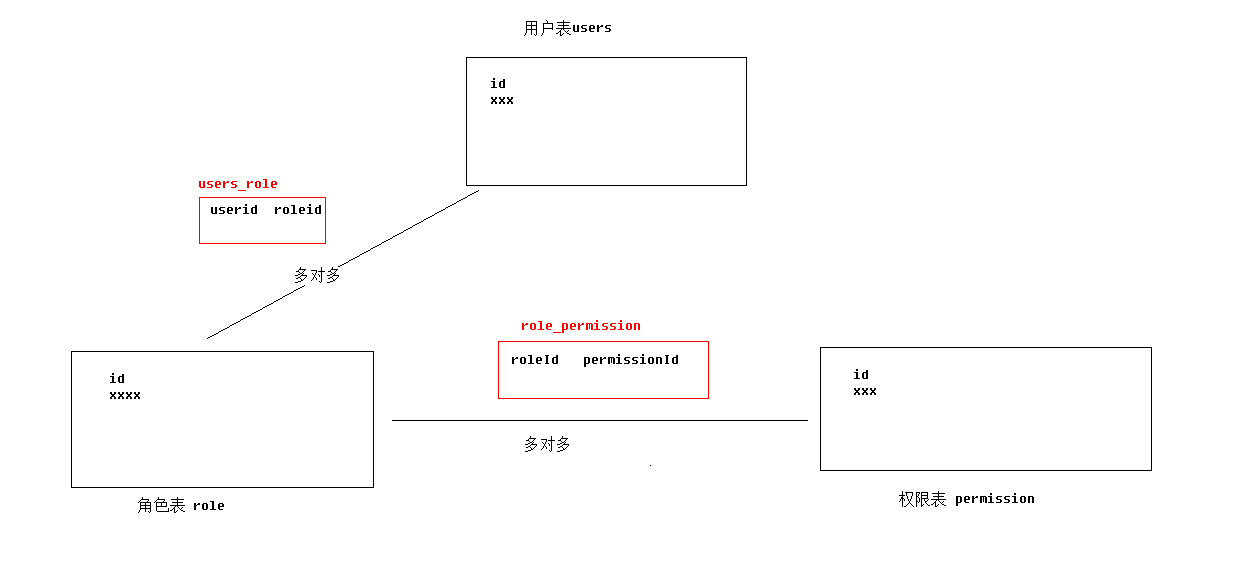
如果删除TABLE ,需要先删除多对多创建的中间表后,才能删除其它主键关联的表。
1.1 用户表
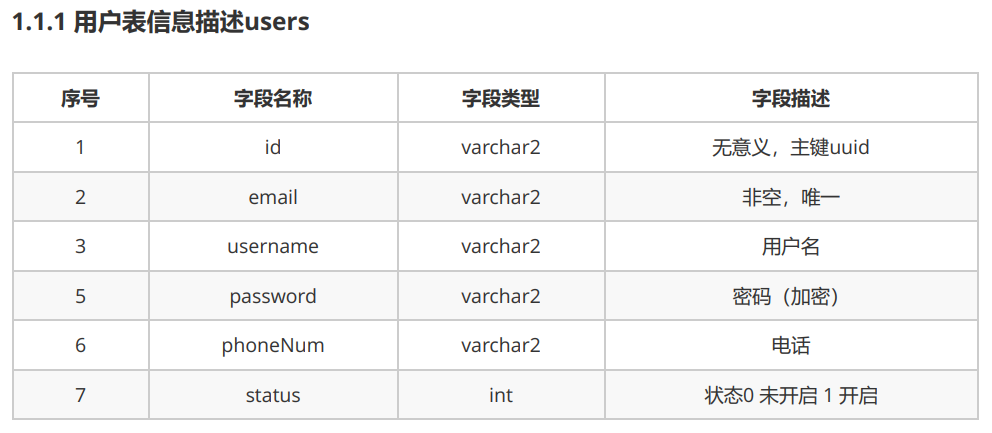
本案例使用oracle数据库
-- 1.1.2 sql语句 CREATE TABLE users( id varchar2(32) default SYS_GUID() PRIMARY KEY, email VARCHAR2(50) UNIQUE NOT NULL, username VARCHAR2(50), PASSWORD VARCHAR2(50), phoneNum VARCHAR2(20), STATUS INT )
实体类
package cn.bjut.ssm.domain; import java.util.List; public class UserInfo { private String id; private String username; private String email; private String password; private String phoneNum; private Integer status; //======成员变量是其它实体类的List<E>===== private String statusStr; private List<Role> roles; public String getStatusStr() { //状态0 未开启 1 开启 if(status!=null){ if(status==0) statusStr="未开启"; if(status==1) statusStr="开启"; } return statusStr; } public void setStatusStr(String statusStr) { this.statusStr = statusStr; } //==========其它get/set方法===============
1.2 角色表

-- 1.2.2 sql语句 CREATE TABLE role( id varchar2(32) default SYS_GUID() PRIMARY KEY, roleName VARCHAR2(50) , roleDesc VARCHAR2(50) )
package cn.bjut.ssm.domain; import org.springframework.security.core.userdetails.User; import java.util.List; public class Role { private String id; private String roleName; private String roleDesc; private List<Permission> permissions; private List<User> users; //=====Role与User以及Permission都是多对多的关系
1.2.3 用户与角色关联关系
用户与角色之间是多对多关系,我们通过user_role表来描述其关联,在实体类中User中存在List,在Role中有List
-- 用户与角色关联表 CREATE TABLE users_role( userId varchar2(32), roleId varchar2(32), PRIMARY KEY(userId,roleId), FOREIGN KEY (userId) REFERENCES users(id), FOREIGN KEY (roleId) REFERENCES role(id) )
1.3 资源权限表

-- 1.3.2 sql语句 CREATE TABLE permission( id varchar2(32) default SYS_GUID() PRIMARY KEY, permissionName VARCHAR2(50) , url VARCHAR2(50) )
package cn.bjut.ssm.domain; import java.util.List; public class Permission { private String id; private String permissionName; private String url; private List<Role> roles; //=====存在一对多关系,则在一的实体类中的成员变量类型是多的List<E> //=====存在一对多关系,则在一的实体类中的成员变量名称是多的names
1.3.3.权限资源与角色关联关系
权限资源与角色是多对多关系,我们使用role_permission表来描述。在实体类Permission中存在List,在Role类中有List
-- 权限资源与角色是多对多关系 CREATE TABLE role_permission( permissionId varchar2(32), roleId varchar2(32), PRIMARY KEY(permissionId,roleId), FOREIGN KEY (permissionId) REFERENCES permission(id), FOREIGN KEY (roleId) REFERENCES role(id) )
2.Spring Security概述
Spring Security 是 Spring 项目组中用来提供安全服务的框架。 安全包括两个主要操作:
“认证”
“授权”
maven依赖
<dependencies> <dependency> <groupId>org.springframework.security</groupId> <artifactId>spring-security-web</artifactId> <version>5.0.10.RELEASE</version> </dependency> <dependency> <groupId>org.springframework.security</groupId> <artifactId>spring-security-config</artifactId> <version>5.0.10.RELEASE</version> </dependency> </dependencies>
Spring Security快速入门
1、导入maven依赖坐标
pom.xml
<?xml version="1.0" encoding="UTF-8"?> <project xmlns="http://maven.apache.org/POM/4.0.0" xmlns:xsi="http://www.w3.org/2001/XMLSchema-instance" xsi:schemaLocation="http://maven.apache.org/POM/4.0.0 http://maven.apache.org/xsd/maven-4.0.0.xsd"> <modelVersion>4.0.0</modelVersion> <groupId>cn.bjut</groupId> <artifactId>springSecurityTest</artifactId> <version>1.0-SNAPSHOT</version> <packaging>war</packaging> <name>springSecurityTest Maven Webapp</name> <!-- FIXME change it to the project's website --> <url>http://www.example.com</url> <properties> <spring.version>5.0.15.RELEASE</spring.version> <spring.security.version>5.0.10.RELEASE</spring.security.version> </properties> <dependencies> <dependency> <groupId>org.springframework</groupId> <artifactId>spring-core</artifactId> <version>${spring.version}</version> </dependency> <dependency> <groupId>org.springframework</groupId> <artifactId>spring-web</artifactId> <version>${spring.version}</version> </dependency> <dependency> <groupId>org.springframework</groupId> <artifactId>spring-webmvc</artifactId> <version>${spring.version}</version> </dependency> <dependency> <groupId>org.springframework</groupId> <artifactId>spring-context-support</artifactId> <version>${spring.version}</version> </dependency> <dependency> <groupId>org.springframework</groupId> <artifactId>spring-test</artifactId> <version>${spring.version}</version> </dependency> <dependency> <groupId>org.springframework</groupId> <artifactId>spring-jdbc</artifactId> <version>${spring.version}</version> </dependency> <dependency> <groupId>org.springframework.security</groupId> <artifactId>spring-security-web</artifactId> <version>${spring.security.version}</version> </dependency> <dependency> <groupId>org.springframework.security</groupId> <artifactId>spring-security-config</artifactId> <version>${spring.security.version}</version> </dependency> <dependency> <groupId>javax.servlet</groupId> <artifactId>javax.servlet-api</artifactId> <version>3.1.0</version> <scope>provided</scope> </dependency> </dependencies> <build> <finalName>springSecurityTest</finalName> <plugins> <!-- java编译插件 --> <plugin> <groupId>org.apache.maven.plugins</groupId> <artifactId>maven-compiler-plugin</artifactId> <version>3.8.0</version> <configuration> <source>1.8</source> <target>1.8</target> <encoding>UTF-8</encoding> </configuration> </plugin> <plugin> <groupId>org.apache.tomcat.maven</groupId> <artifactId>tomcat7-maven-plugin</artifactId> <version>2.2</version> <configuration> <!-- 指定端口 --> <port>8090</port> <!-- 请求路径 --> <path>/</path> </configuration> </plugin> </plugins> </build> </project>
2、在WEB-INF目录下的 web.xml中配置<filter>
<?xml version="1.0" encoding="UTF-8"?> <web-app xmlns:xsi="http://www.w3.org/2001/XMLSchema-instance" xmlns="http://java.sun.com/xml/ns/javaee" xsi:schemaLocation="http://java.sun.com/xml/ns/javaee http://java.sun.com/xml/ns/javaee/web-app_2_5.xsd" version="2.5"> <display-name>SpringSecurityTest</display-name> <context-param> <param-name>contextConfigLocation</param-name> <param-value>classpath:spring-security.xml</param-value> </context-param> <listener> <listener-class>org.springframework.web.context.ContextLoaderListener</listener-class> </listener> <filter> <filter-name>springSecurityFilterChain</filter-name> <filter-class>org.springframework.web.filter.DelegatingFilterProxy</filter-class> </filter> <filter-mapping> <filter-name>springSecurityFilterChain</filter-name> <url-pattern>/*</url-pattern> </filter-mapping> <welcome-file-list> <welcome-file>index.html</welcome-file> <welcome-file>index.htm</welcome-file> <welcome-file>index.jsp</welcome-file> <welcome-file>default.html</welcome-file> <welcome-file>default.htm</welcome-file> <welcome-file>default.jsp</welcome-file> </welcome-file-list> </web-app>
3、在 classpath:spring-security.xml 里面配置安全认证用到的用户信息。
<?xml version="1.0" encoding="UTF-8"?> <beans xmlns="http://www.springframework.org/schema/beans" xmlns:security="http://www.springframework.org/schema/security" xmlns:xsi="http://www.w3.org/2001/XMLSchema-instance" xsi:schemaLocation="http://www.springframework.org/schema/beans http://www.springframework.org/schema/beans/spring-beans.xsd http://www.springframework.org/schema/security http://www.springframework.org/schema/security/spring-security.xsd"> <security:http auto-config="true" use-expressions="false"> <!-- intercept-url定义一个过滤规则 pattern表示对哪些url进行权限控制,access属性表示在请求对应 的URL时需要什么权限, 默认配置时它应该是一个以逗号分隔的角色列表,请求的用户只需拥有其中的一个角色就能成功访问对应 的URL --> <security:intercept-url pattern="/**" access="ROLE_USER" /> <!-- auto-config配置后,不需要在配置下面信息 <security:form-login /> 定义登录表单信息 <security:http-basic/> <security:logout /> --> </security:http> <security:authentication-manager> <security:authentication-provider> <security:user-service> <security:user name="user" password="{noop}user" authorities="ROLE_USER" /> <security:user name="admin" password="{noop}admin" authorities="ROLE_ADMIN" /> </security:user-service> </security:authentication-provider> </security:authentication-manager> </beans>
2.2.5 springSecurity快速入门:使用自定义页面
spring-security.xml配置
<?xml version="1.0" encoding="UTF-8"?> <beans xmlns="http://www.springframework.org/schema/beans" xmlns:security="http://www.springframework.org/schema/security" xmlns:xsi="http://www.w3.org/2001/XMLSchema-instance" xsi:schemaLocation="http://www.springframework.org/schema/beans http://www.springframework.org/schema/beans/spring-beans.xsd http://www.springframework.org/schema/security http://www.springframework.org/schema/security/spring-security.xsd"> <!-- 配置不过滤的资源(静态资源及登录相关) --> <security:http security="none" pattern="/login.html" /> <security:http security="none" pattern="/failer.html" /> <security:http auto-config="true" use-expressions="false"> <!-- 配置资料连接,表示任意路径都需要ROLE_USER权限 --> <security:intercept-url pattern="/**" access="ROLE_USER" /> <!-- 自定义登陆页面,login-page 自定义登陆页面 authentication-failure-url 用户权限校验失败之 后才会跳转到这个页面,如果数据库中没有这个用户则不会跳转到这个页面。 default-target-url 登陆成功后跳转的页面。 注:登陆页面用户名固定 username,密码 password,action:login --> <security:form-login login-page="/login.html" login-processing-url="/login" username-parameter="username" password-parameter="password" authentication-failure-url="/failer.html" authentication-success-forward-url="/success.html" default-target-url="/success.html" /> <!-- 登出, invalidate-session 是否删除session logout-url:登出处理链接 logout-successurl:登出成功页面 注:登出操作 只需要链接到 logout即可登出当前用户 --> <security:logout invalidate-session="true" logout-url="/logout" logout-success-url="/login.jsp" /> <!-- 关闭CSRF,默认是开启的 --> <security:csrf disabled="true" /> </security:http> <security:authentication-manager> <security:authentication-provider> <security:user-service> <security:user name="user" password="{noop}user" authorities="ROLE_USER" /> <security:user name="admin" password="{noop}admin" authorities="ROLE_ADMIN" /> </security:user-service> </security:authentication-provider> </security:authentication-manager> </beans>
2.3 Spring Security使用数据库认证
在Spring Security中如果想要使用数据进行认证操作,有很多种操作方式,这里我们介绍使用UserDetails接口、UserDetailsService来完成操作。
UserDetails作用是于封装当前进行认证的用户信息,但由于其是一个接口,
所以我们可以对其进行实现,也可以使用Spring Security提供的一个UserDetails的实现类User来完成操作。public class User implements UserDetails, CredentialsContainer { private String password; private final String username; private final Set<GrantedAuthority> authorities; private final boolean accountNonExpired; //帐户是否过期 private final boolean accountNonLocked; //帐户是否锁定 private final boolean credentialsNonExpired; //认证是否过期 private final boolean enabled; //帐户是否可用 }UserDetailsService
public interface UserDetailsService { UserDetails loadUserByUsername(String username) throws UsernameNotFoundException; }
3. 用户管理
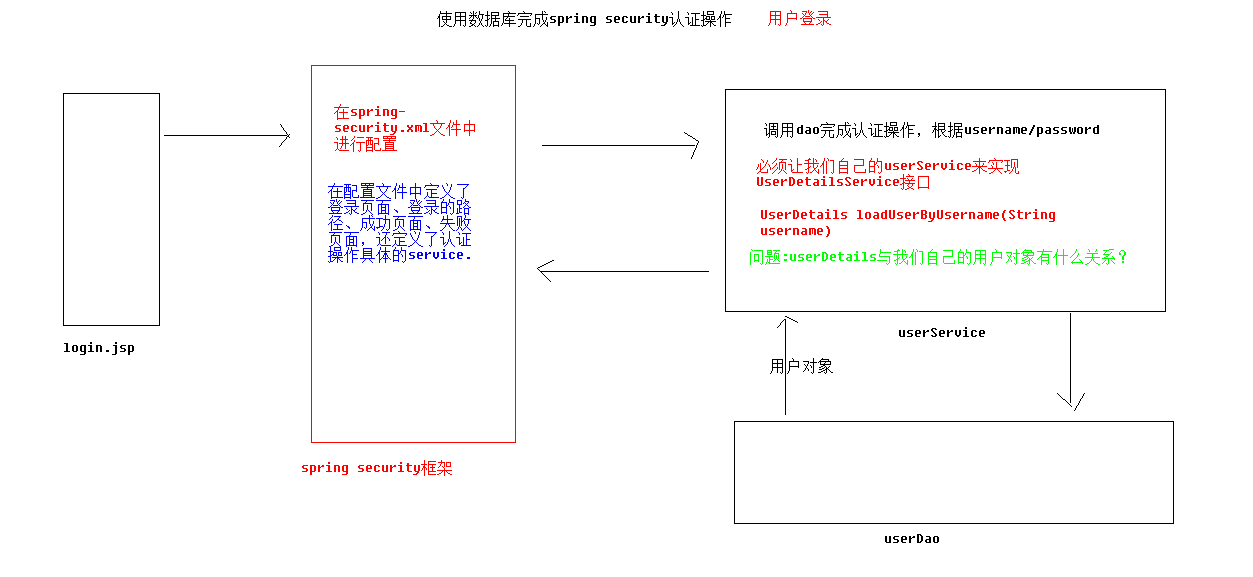
3.1 用户登录
webapp/WEB-INF目录下的
web.xml
<?xml version="1.0" encoding="UTF-8"?> <web-app xmlns:xsi="http://www.w3.org/2001/XMLSchema-instance" xmlns="http://xmlns.jcp.org/xml/ns/javaee" xsi:schemaLocation="http://xmlns.jcp.org/xml/ns/javaee http://xmlns.jcp.org/xml/ns/javaee/web-app_3_1.xsd" version="3.1"> <!-- 声明加载spring框架配置文件的路径 --> <context-param> <param-name>contextConfigLocation</param-name> <param-value>classpath*:applicationContext.xml,classpath*:spring-security.xml</param-value> </context-param> <!-- 配置spring-web监听器 --> <listener> <listener-class>org.springframework.web.context.ContextLoaderListener</listener-class> </listener> <!-- 配置监听器,监听request域对象的创建和销毁的 --> <listener> <listener-class>org.springframework.web.context.request.RequestContextListener</listener-class> </listener> <!-- 前端控制器(加载classpath:springmvc.xml 服务器启动创建servlet) --> <servlet> <servlet-name>dispatcherServlet</servlet-name> <servlet-class>org.springframework.web.servlet.DispatcherServlet</servlet-class> <!-- 配置初始化参数,创建完DispatcherServlet对象,加载springmvc.xml配置文件 --> <init-param> <param-name>contextConfigLocation</param-name> <param-value>classpath:springmvc.xml</param-value> </init-param> <!-- 服务器启动的时候,让DispatcherServlet对象创建 --> <load-on-startup>1</load-on-startup> </servlet> <servlet-mapping> <servlet-name>dispatcherServlet</servlet-name> <url-pattern>*.do</url-pattern> </servlet-mapping> <!-- 解决中文乱码过滤器 --> <filter> <filter-name>characterEncodingFilter</filter-name> <filter-class>org.springframework.web.filter.CharacterEncodingFilter</filter-class> <init-param> <param-name>encoding</param-name> <param-value>UTF-8</param-value> </init-param> </filter> <filter-mapping> <filter-name>characterEncodingFilter</filter-name> <url-pattern>/*</url-pattern> </filter-mapping> <!--委派springSecurity过滤器--> <filter> <filter-name>springSecurityFilterChain</filter-name> <filter-class>org.springframework.web.filter.DelegatingFilterProxy</filter-class> </filter> <filter-mapping> <filter-name>springSecurityFilterChain</filter-name> <url-pattern>/*</url-pattern> </filter-mapping> <welcome-file-list> <welcome-file>index.html</welcome-file> <welcome-file>index.htm</welcome-file> <welcome-file>index.jsp</welcome-file> <welcome-file>default.html</welcome-file> <welcome-file>default.htm</welcome-file> <welcome-file>default.jsp</welcome-file> </welcome-file-list> </web-app>
配置在web项目的resources目录下的
spring-security.xml
<?xml version="1.0" encoding="UTF-8"?> <beans xmlns="http://www.springframework.org/schema/beans" xmlns:security="http://www.springframework.org/schema/security" xmlns:xsi="http://www.w3.org/2001/XMLSchema-instance" xsi:schemaLocation="http://www.springframework.org/schema/beans http://www.springframework.org/schema/beans/spring-beans.xsd http://www.springframework.org/schema/security http://www.springframework.org/schema/security/spring-security.xsd"> <!-- 配置不拦截的静态资源和登录相关页面 --> <security:http pattern="/login.jsp" security="none"/> <security:http pattern="/failer.jsp" security="none"/> <security:http pattern="/css/**" security="none"/> <security:http pattern="/img/**" security="none"/> <security:http pattern="/images/**" security="none"/> <security:http pattern="/plugins/**" security="none"/> <!-- 配置具体的规则 auto-config="false" 选用自己编写登录的页面,不用框架提供的默认登录页面 use-expressions="false" 是否使用SPEL表达式(还没学习过) --> <security:http auto-config="false" use-expressions="true" > <!-- 配置具体的拦截的规则 pattern="请求路径的规则" access="访问系统的人,必须有ROLE_USER的角色" --> <security:intercept-url pattern="/**" access="hasAnyRole('ROLE_USER','ROLE_ADMIN')"/> <!--<security:intercept-url pattern="/**" access="ROLE_USER,ROLE_ADMIN"/>--> <!--如果没有login-processing-url这一属性,那么登录表单的action,必须为j_spring_secutity_check--> <!-- 定义跳转的具体的页面 --> <security:form-login login-page="/login.jsp" login-processing-url="/login" username-parameter="username" password-parameter="password" default-target-url="/index.jsp" authentication-failure-url="/failer.jsp" authentication-success-forward-url="/index.jsp" /> <!-- 关闭跨域请求 --> <security:csrf disabled="true"/> <!-- 退出 --> <security:logout invalidate-session="true" logout-url="/logout.do" logout-success-url="/login.jsp" /> </security:http> <!-- 切换成数据库中的用户名和密码 --> <security:authentication-manager> <security:authentication-provider user-service-ref="userService"> <!-- 配置加密的方式 --> <!--<security:password-encoder ref="passwordEncoder"/>--> </security:authentication-provider> </security:authentication-manager> <!-- 配置加密类 --> <!--<bean id="passwordEncoder" class="org.springframework.security.crypto.bcrypt.BCryptPasswordEncoder"/>--> <!-- 提供了入门的方式,在内存中存入用户名和密码 <security:authentication-manager> <security:authentication-provider> <security:user-service> <security:user name="admin" password="{noop}admin" authorities="ROLE_USER"/> </security:user-service> </security:authentication-provider> </security:authentication-manager> --> </beans>
自己编写用到的
userServiceImpl实现类
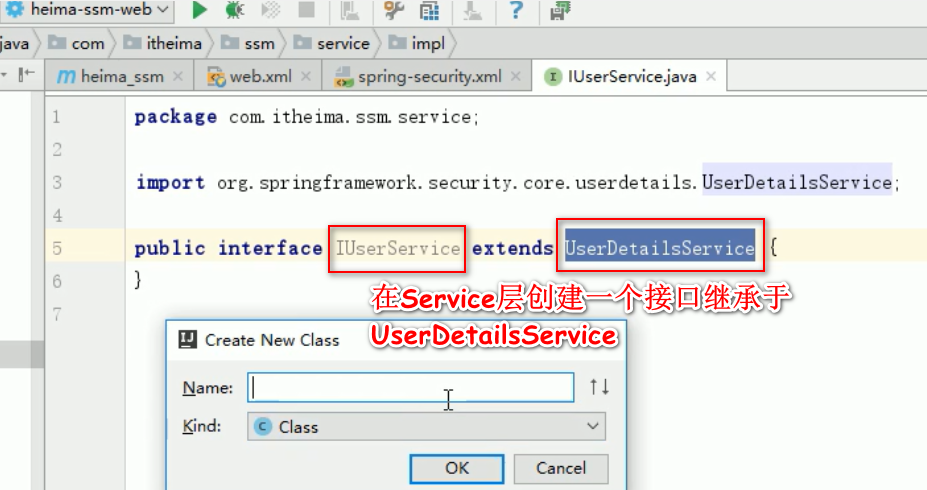

package cn.bjut.ssm.service.impl; import cn.bjut.ssm.dao.IUserDao; import cn.bjut.ssm.domain.UserInfo; import cn.bjut.ssm.service.IUserService; import org.springframework.beans.factory.annotation.Autowired; import org.springframework.security.core.authority.SimpleGrantedAuthority; import org.springframework.security.core.userdetails.User; import org.springframework.security.core.userdetails.UserDetails; import org.springframework.security.core.userdetails.UsernameNotFoundException; import org.springframework.stereotype.Service; import org.springframework.transaction.annotation.Transactional; import java.util.ArrayList; import java.util.List; @Service(value = "userService") @Transactional //注解的方式使用spring事务管理 public class UserServiceImpl implements IUserService { @Autowired IUserDao userDao; @Override public UserDetails loadUserByUsername(String username) throws UsernameNotFoundException { //UserInfo是domain包下的实体类 UserInfo userInfo = null; try{ userInfo = userDao.findByUsername(username); } catch(Exception e){ e.printStackTrace(); } //把自己查询到的实体类中的认证信息封装成UserDetails //"{noop}"使用密码明文的必要前缀 User user = new User(userInfo.getUsername(),"{noop}"+userInfo.getPassword(),getAuthority()); return user; } //这个成员方法作用就是返回一个List集合,集合中装入的是角色描述。 //实际项目中应该是从数据库中获取role描述后封装到这个方法体里面。 public List<SimpleGrantedAuthority> getAuthority(){ List<SimpleGrantedAuthority> list = new ArrayList<>(); // new 匿名对象 list.add(new SimpleGrantedAuthority("ROLE_USER")); return list; } }
在DAO层写一个Java的 Interface ,用来查询用户信息,获取username和password查询结果集封装在实体类中。
package cn.bjut.ssm.dao; import cn.bjut.ssm.domain.UserInfo; import org.apache.ibatis.annotations.Select; public interface IUserDao { @Select("select * from USERS where username = #{username}") public UserInfo findByUsername(String username) throws Exception; }
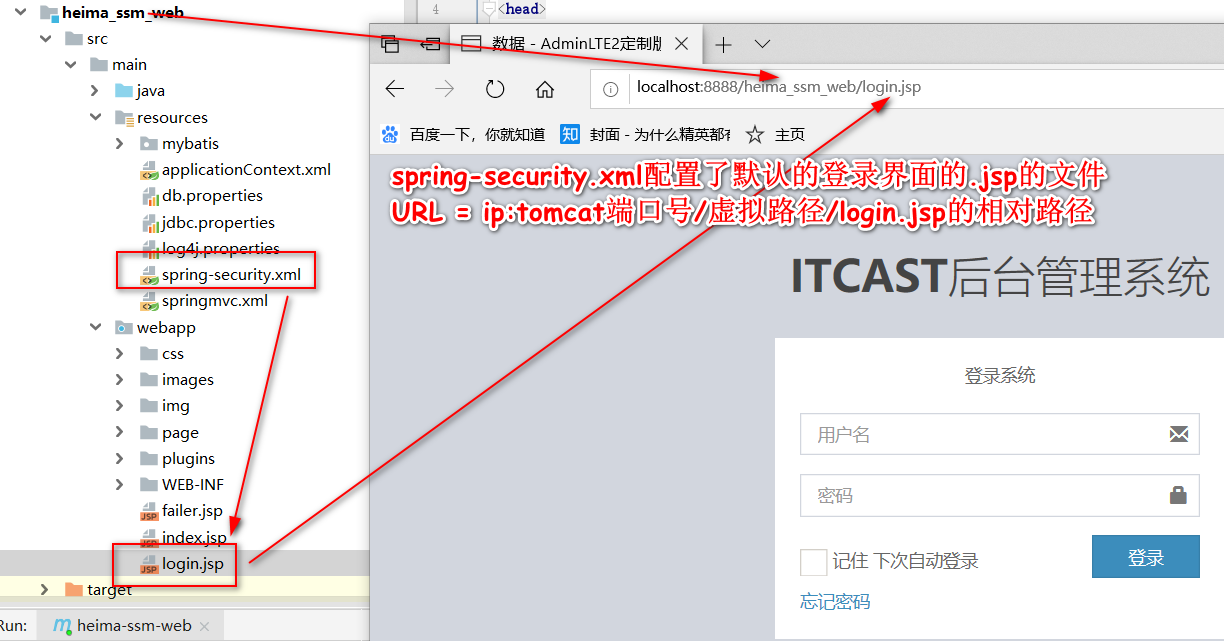
使用PL/SQL Developer插入一条完整用户数据到USERS表如下:
-- 查询user表 select * from users t; -- 插入一条users表数据 insert into users values('1101112019','itheima@itcast.cn','ssm08','itheima','15612345678',1);
运行版本报错信息为:WARN o.bcrypt.BCryptPasswordEncoder - Encoded password does not look like BCrypt;
因为spring-security在最新版本升级后,默认把之前的明文密码方式给去掉了官方文档说明。
参考资料:
使用Spring Security下的BCryptPasswordEncoder进行密码加密
SpringBoot Security:Encoded password does not look like BCrypt 解决
spring-cloud-oauth2升级版本遇到的认证报bad credentials,Encoded password does not look likebcrypt的问题
index.jsp
<%@ page language="java" contentType="text/html; charset=UTF-8" pageEncoding="UTF-8"%> <html> <head> <title>默认主页</title> </head> <body> <p>你正在浏览webapp目录下的index.jsp</p><br> 超链接标签请求的href后面访问不到WEB-INF目录里的jsp文件<br> <a href="${pageContext.request.contextPath}/pages/main.jsp">点击跳转到:/webapp/pages/main.jsp</a><br> <%--<jsp:forward page="/pages/main.jsp"></jsp:forward>--%> <jsp:forward page="./WEB-INF/pages2/main2.jsp"></jsp:forward> </body> </html>
截止目前我发现如果浏览器想访问WEB-INF目录里的.jsp页面,首先可以通过springMVC的视图解析器配置通过返回ModelAndView访问到,再有就是通过<jsp:forward page=" /WEB-INF"> 跳转访问。
-- 插入一条记录到角色表记录 insert into ROLE values ('12345','ADMIN','vip'); -- 插入一条用户-角色中间表记录 insert into USERS_ROLE values('1101112019','12345');
package cn.bjut.ssm.dao; import cn.bjut.ssm.domain.Role; import org.apache.ibatis.annotations.Select; import java.util.List; public interface IRoleDao { //根据用户ID查询出所有对应的角色 @Select("select * from ROLE where id in( select ROLEID from USERS_ROLE where USERID = #{userId})") public List<Role> findRoleByUserId(String userId) throws Exception; }
public interface IUserDao { @Select("select * from USERS where username = #{username}") @Results({ @Result(property = "id",column = "id",id = true), @Result(property = "username",column = "username"), @Result(property = "email",column = "email"), @Result(property = "password",column = "password"), @Result(property = "phoneNum",column = "phoneNum"), @Result(property = "status",column = "status"), //通过中间表查询多对多关系,返回一个其它实体类的List集合 @Result(property = "roles",column = "id",javaType =java.util.List.class,many = @Many(select = "cn.bjut.ssm.dao.IRoleDao.findRoleByUserId")) }) public UserInfo findByUsername(String username) throws Exception; }
这是不考虑Role的可用/不可用状态时的认证实现类
@Service(value = "userService") @Transactional //注解的方式使用spring事务管理 public class UserServiceImpl implements IUserService { @Autowired IUserDao userDao; @Override public UserDetails loadUserByUsername(String username) throws UsernameNotFoundException { //UserInfo是domain包下的实体类 UserInfo userInfo = null; try{ userInfo = userDao.findByUsername(username); } catch(Exception e){ e.printStackTrace(); } //把自己查询到的实体类中的认证信息封装成UserDetails //"{noop}"使用密码明文的必要前缀 User user = new User(userInfo.getUsername(),"{noop}"+userInfo.getPassword(),getAuthority(userInfo.getRoles())); return user; } //这个成员方法作用就是返回一个List集合,集合中装入的是角色描述。 //实际项目中应该是从数据库中获取role描述后封装到这个方法体里面。 public List<SimpleGrantedAuthority> getAuthority(List<Role> roles){ List<SimpleGrantedAuthority> list = new ArrayList<>(); //增强for循环 for (Role role :roles){ // new 匿名对象 list.add(new SimpleGrantedAuthority("ROLE_"+role.getRoleName())); } return list; }
考虑用户表中状态值:
//状态0 未开启 1 开启
使用了三元运算符进行判断
@Service(value = "userService") @Transactional //注解的方式使用spring事务管理 public class UserServiceImpl implements IUserService { @Autowired IUserDao userDao; @Override public UserDetails loadUserByUsername(String username) throws UsernameNotFoundException { //UserInfo是domain包下的实体类 UserInfo userInfo = null; try{ userInfo = userDao.findByUsername(username); } catch(Exception e){ e.printStackTrace(); } //把自己查询到的实体类中的认证信息封装成UserDetails //"{noop}"使用密码明文的必要前缀 // User user = new User(userInfo.getUsername(),"{noop}"+userInfo.getPassword(),getAuthority(userInfo.getRoles())); User user = new User(userInfo.getUsername(),"{noop}"+userInfo.getPassword(),userInfo.getStatus() ==0 ?false:true,true,true,true,getAuthority(userInfo.getRoles())); return user; } //这个成员方法作用就是返回一个List集合,集合中装入的是角色描述。 //实际项目中应该是从数据库中获取role描述后封装到这个方法体里面。 public List<SimpleGrantedAuthority> getAuthority(List<Role> roles){ List<SimpleGrantedAuthority> list = new ArrayList<>(); //增强for循环 for (Role role :roles){ // new 匿名对象 list.add(new SimpleGrantedAuthority("ROLE_"+role.getRoleName())); } return list; }
====================
end